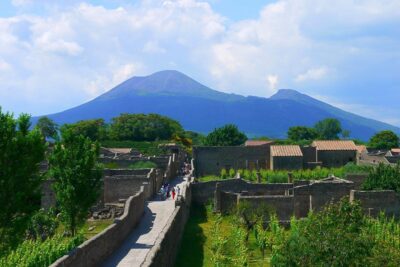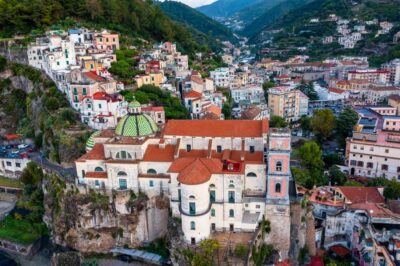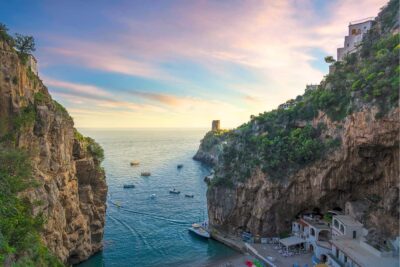Raito is a hamlet of Vietri sul Mare, nestled among the green terraced hills with a magnificent direct view of the sea. “Raito, salus infirmorum” (Raito, salus infirmorum) is the inscription that welcomes visitors and tourists at the beginning of the road that climbs up the hill towards the village.
This hamlet is world famous for its stairways, the only way to get around and visit the village, which has only two roads, one at the top and one at the bottom, well connected by Vietri bus lines.
A UNESCO World Heritage Site together with the Amalfi Coast, its name derives from the Latin word ‘ragitus’, meaning sun-kissed: its geographical position, in fact, makes it exposed to the sun all day long and from the top of its hill it dominates the Gulf of Salerno.
Indice dei contenuti
The Villa Guariglia
One of the most important monuments in Raito and the entire area is the Villa Guariglia, named after its owner Raffaele Guariglia, who donated the monument to the Provincial Administration of Salerno so that a Centre for Study could be created.
The villa was the residence of Victor Emmanuel III of Savoy during the Second World War; then in 1970, the ambassador’s death made the Guariglia Study Centre a prestigious destination for scholars of the calibre of Raffaele Cantarella and Giovanni Pugliese Carratelli.
Today, the villa is home to the Provincial Museum of Ceramics, created in 1981 and entirely dedicated to the famous ceramics of the coast. The exhibition occupies the Torretta and the ground floor of the building with pieces representative of the area’s ceramic production: it is a true journey through the history of the coast through the most beautiful and precious pieces of ceramics.
The museum exhibits objects and works by Richard Dölker and his wife Elle Schwarz; ceramics by Giovannino Carrano, Vincenzo Pinto, Giosuè and Salvatore Procida, Guido Gambone and several more recent Vietri artists and craftsmen to whom this important art was handed down. Since 1999, several private collections acquired by the Cultural Heritage of the Province of Salerno have also been exhibited in the Villa.
A third section of the museum was opened in 2001, entirely dedicated to ‘riggiole’. The ‘riggiole’ is a local dialect expression that means “tile”: it is than a type of ceramic tile, often hand-painted majolica. These tiles are typical of the Amalfi Coast area and are used to cover both the floors and walls of homes.
The Villa Guariglia is surrounded by a park with typical Mediterranean vegetation, in the classic terraced layout. A marvellous and evocative panorama can be enjoyed from these terraces; while observing Raito from the sea, it almost seems like a precious stone set in the green of the hills that contrasts with the blue of the sky, almost as if they were joined on the horizon line.
Also worth a visit is the small and graceful church of Santa Maria delle Grazie, dating back to the 15th century, which has three naves. There are several accommodation facilities to stay in this enchanting place and admire the coastline from above.
The Villa Guariglia is famous throughout the world for its magnificence, but it is especially so in Italy because it is here that the television drama ‘Capri’ was filmed. In the fiction, the villa was renamed Villa Isabella and hinted at the beauty of the place.
The spotlight is often shone on the town thanks to the conferences, exhibitions, concerts and shows that are organised in the splendid setting of Villa Guariglia. There are two music-related events of particular note: the ‘Vietri sul Mare – Costa Amalfitana’ International Piano Competition and the ‘Summer Concerts at Villa Guariglia’, both aimed at attracting tourists and boosting the local economy.
The Church of Santa Maria delle Grazie
Strolling through the small town of Raito, situated in a panoramic position offering striking views of the Gulf of Salerno, you will come across the Church of Santa Maria delle Grazie, built in 1540.
The sacred building has a three-nave Latin cross structure. On the high altar, you will observe a marble bas-relief depicting the Dead Christ with angels, while among the side chapels, the one dedicated to sailors, with works by Luca Giordano, is certainly interesting.
A tour of the village between ‘scalinatelle’ and ceramics
Between one ‘scalinatella’ (small staircase) and another, you will walk through the village, passing quiet, peaceful dwellings. You will notice the small fountains, very common in the villages and streets of the Amalfi Coast: a small thing, but one that beautifully renders the sense of hospitality and ‘home’ that you breathe among these places.
Your silent stroll will allow you to lay your eyes on small details of an ancient village: the small balconies with the laundry hung out to dry in the sun, the typical decorative tiles, present almost everywhere, both next to the houses and in the streets, as delightful and colourful street furniture, the flowering windows, arches and balconies, the occasional kitten resting peacefully.
In short, a stroll through Raito’s ‘scalinatelle’ will give you the chance to discover an authentic village that has resisted the passage of time, keeping its essence and characteristics intact: a little journey through time that we recommend if you want to get off the usual routes and away from the more iconic and decidedly more crowded destinations on the Amalfi Coast.
Don’t forget to make a contemplative stop at the belvedere in Piazzetta Rigiuolo: from here you can admire a splendid panorama, observing Vietri sul Mare and the Gulf of Salerno.
How to reach Raito
We advise you to reach the village of Raito with the SITA SUD buses that leave from Vietri sul Mare. You can buy tickets at authorised UNICO sellers or by downloading the unico App, which allows you to purchase tickets directly from your smartphone.
If you want to reach Raito by car (it may be difficult to find parking), from the A3 motorway take the exit for Vietri sul Mare and follow the signs for Raito. If you are coming from the Caserta – Salerno motorway, after the service station, continue to Salerno (about 15 km), take the Salerno exit and follow the signs for Vietri sul Mare, from where you will proceed to Raito.
If you are looking for more information on how best to organise your travels along the Amalfi Coast, we recommend downloading our free guide “How to get around the Amalfi Coast without stress“. Inside, we have included all the tips for travelling between the towns on the Amalfi Coast, both by car and by public transport, as well as the invaluable list of car and motorbike parking spaces on the Amalfi Coast,









